It looks like you're using an Ad Blocker.
Please white-list or disable AboveTopSecret.com in your ad-blocking tool.
Thank you.
Some features of ATS will be disabled while you continue to use an ad-blocker.
share:
Does this look weird? What is your take on this rock? can anyone say how big it is?
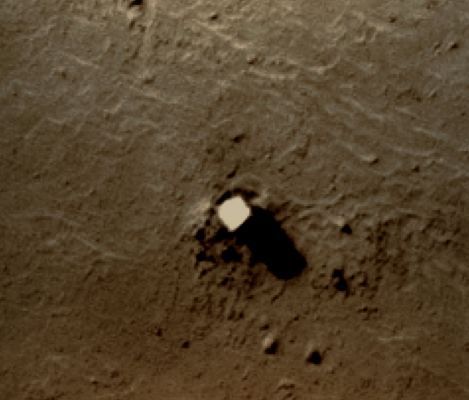
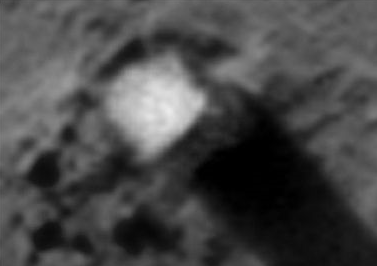

hirise.lpl.arizona.edu...
JP2 DOWNLOAD
Grayscale: map-projected (1219.8 MB)



hirise.lpl.arizona.edu...
JP2 DOWNLOAD
Grayscale: map-projected (1219.8 MB)
edit on 1-1-2015 by jamie6737 because: (no reason given)
Looks like dirt is mounded up around the bottom. Reminds me of an uneven obelisk. I can't tell how big it is, if it's man-sized it seems like a post
stuck in the ground, with dirt bunched up to help support it. Could be much, much larger though...
If you can get a date and time of when the photo was taken and its rough coordinates on Mars, you'd be able to calculate its height based on its
shadow.
Of course, you'd also need a scale reference as well... For that, you'd need to know what 1cm3 of the image is in meters et c.
If NASA provides that information, then it would be quite easy to figure out its dimensions.
Edit to add;
All the information you need is on the link;
Additional;
www.gislounge.com...
For information on how to calculate its height with the above information.
Of course, you'd also need a scale reference as well... For that, you'd need to know what 1cm3 of the image is in meters et c.
If NASA provides that information, then it would be quite easy to figure out its dimensions.
Edit to add;
All the information you need is on the link;
Acquisition date: 03 January 2008
Local Mars time: 2:45 PM
Latitude (centered): -53.113° Longitude (East): 125.439°
Original image scale range: 25.0 cm/pixel (with 1 x 1 binning) so objects ~75 cm across are resolved
Map projected scale: 25 cm/pixel and North is up
edit on 1/1/2015 by Sovaka because: (no reason given)
Additional;
www.gislounge.com...
For information on how to calculate its height with the above information.
edit on 1/1/2015 by Sovaka because: (no reason given)
Isn't that the "monolith" on Phobos, one of the moons of Mars?
It is an odd formation, to be sure... if not artificial, then a really interesting geologic formation that doesn't make much sense in space...with no "weathering."
ETA: Oh it IS on Mars... then weathering isn't weird... but compare that shot to the pillar on Phobos and see if it isn't almost an exact match.
EETA: Nope that IS on Phobos!! Same shape and irregularities and even the same shadow.
It is an odd formation, to be sure... if not artificial, then a really interesting geologic formation that doesn't make much sense in space...with no "weathering."
ETA: Oh it IS on Mars... then weathering isn't weird... but compare that shot to the pillar on Phobos and see if it isn't almost an exact match.
edit on 1/1/2015 by Baddogma because: (no reason given)
EETA: Nope that IS on Phobos!! Same shape and irregularities and even the same shadow.
edit on 1/1/2015 by Baddogma because: (no reason
given)
originally posted by: Baddogma
Isn't that the "monolith" on Phobos, one of the moons of Mars?
It is an odd formation, to be sure... if not artificial, then a really interesting geologic formation that doesn't make much sense in space...with no "weathering."
ETA: Oh it IS on Mars... then weathering isn't weird... but compare that shot to the pillar on Phobos and see if it isn't almost an exact match.
EETA: Nope that IS on Phobos!! Same shape and irregularities and even the same shadow.
That is a Mars picture.
a reply to: Soylent Green Is People
The 1st and 2nd (black and white) photograph is what came up when googling "Phobos Monolith." I guess the sites are wrong and it's really on Mars, which isn't surprising... but if they are separate pics of two different features than the match is... exact!
Just likely mislabeled images ... which is SO unusual on the internet (sarcasm).
ETA and after checking several such sites that include Newspapers, sure enough, they've confused this image with the Phobos monolith. So this image is indeed on Mars... and likely a natural butte, mesa or volcanic vent weathered out of softer rock. Cool none the less.
The 1st and 2nd (black and white) photograph is what came up when googling "Phobos Monolith." I guess the sites are wrong and it's really on Mars, which isn't surprising... but if they are separate pics of two different features than the match is... exact!
Just likely mislabeled images ... which is SO unusual on the internet (sarcasm).
ETA and after checking several such sites that include Newspapers, sure enough, they've confused this image with the Phobos monolith. So this image is indeed on Mars... and likely a natural butte, mesa or volcanic vent weathered out of softer rock. Cool none the less.
edit on 1/1/2015 by
Baddogma because: (no reason given)
that is the flag for hole 9 I think....
seriously its a quite an impressive shadow though
seriously its a quite an impressive shadow though
originally posted by: Sovaka
If you can get a date and time of when the photo was taken and its rough coordinates on Mars, you'd be able to calculate its height based on its shadow.
It's easier than that, as they have the "solar incidence angle", the Sun was 22º above the horizon.
Edit: if my calculations are correct, that rock is 2.75 metres wide and 2.4 metres high.
edit on 1/1/2015 by ArMaP because: (no reason
given)
THAT is where my old freezer went!!
j/k of course.
Very interesting looking.
Are there any other rocks looking even vaguely like it?
j/k of course.
Very interesting looking.
Are there any other rocks looking even vaguely like it?
Looking at that thing . I was asking myself if the surrounding dirt or sand had to be more crater like?
If it was something that came down from space I would think the rock would be more crumbled then it supposed to be right now .
So I think that it has to be something from another impact ?
If it was something that came down from space I would think the rock would be more crumbled then it supposed to be right now .
So I think that it has to be something from another impact ?
edit on 0b54America/ChicagoFri, 02 Jan 2015 02:59:54 -0600vAmerica/ChicagoFri, 02
Jan 2015 02:59:54 -06001 by 0bserver1 because: (no reason given)
Well spotted, that's a very interesting rock!
Given the stated image resolution of 25.0 cm/pixel, and a top-down view, this rock measures about 5 by 5 meteres.
Here it is at the original image resolution:
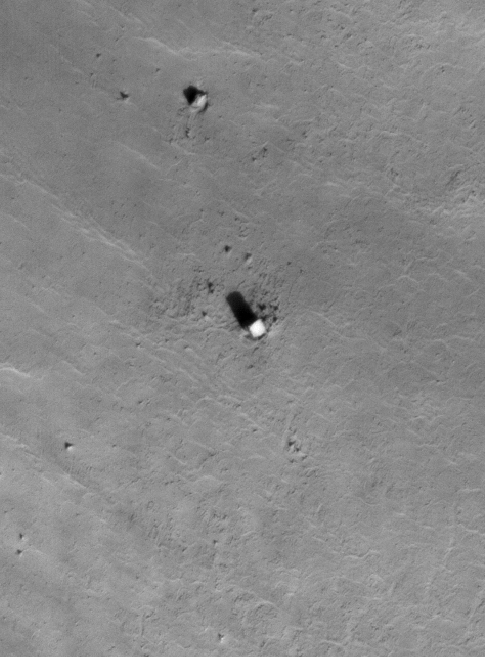
There are lots of similarly-sized and similarly-shaped rocks scattered around that area, so I'd go with this being a natural rock, just more rectangular than others.
Given the stated image resolution of 25.0 cm/pixel, and a top-down view, this rock measures about 5 by 5 meteres.
Here it is at the original image resolution:

There are lots of similarly-sized and similarly-shaped rocks scattered around that area, so I'd go with this being a natural rock, just more rectangular than others.
edit on 2-1-2015 by wildespace because: (no reason given)
originally posted by: Sovaka
a reply to: ArMaP
I am not going to download the full 1.3Gb image to actually measure the bugger.
You don't have to, as they have included a software to view the huge JP2 files: HiView. That's what I used to take that 1:1 resolution screenshot.
Video tutorial on using HiView: www.youtube.com...
The Sun was low above the horizon, hence the long shadow. However, I'd like for someone to do the calculations and tell us the height estimate
edit on 2-1-2015 by wildespace because: (no reason given)
originally posted by: Sovaka
Hmm not so sure about that...
I am (now).
According to the information, its 25cm per pixel.
I am not going to download the full 1.3Gb image to actually measure the bugger.
Perhaps the OP can and then do a pixel count of its width and length.
I didn't download the 1.3Gb JPEG2000 image, but I downloaded the 20 IMG files (at 70.8Mb each) so I could use the images in ISIS (Integrated software for imagers and spectrometers), the (free) software they use to process the images, as one of the programs of the ISIS suite has a toll for measuring the images. It was from that program that I got these screenshots.
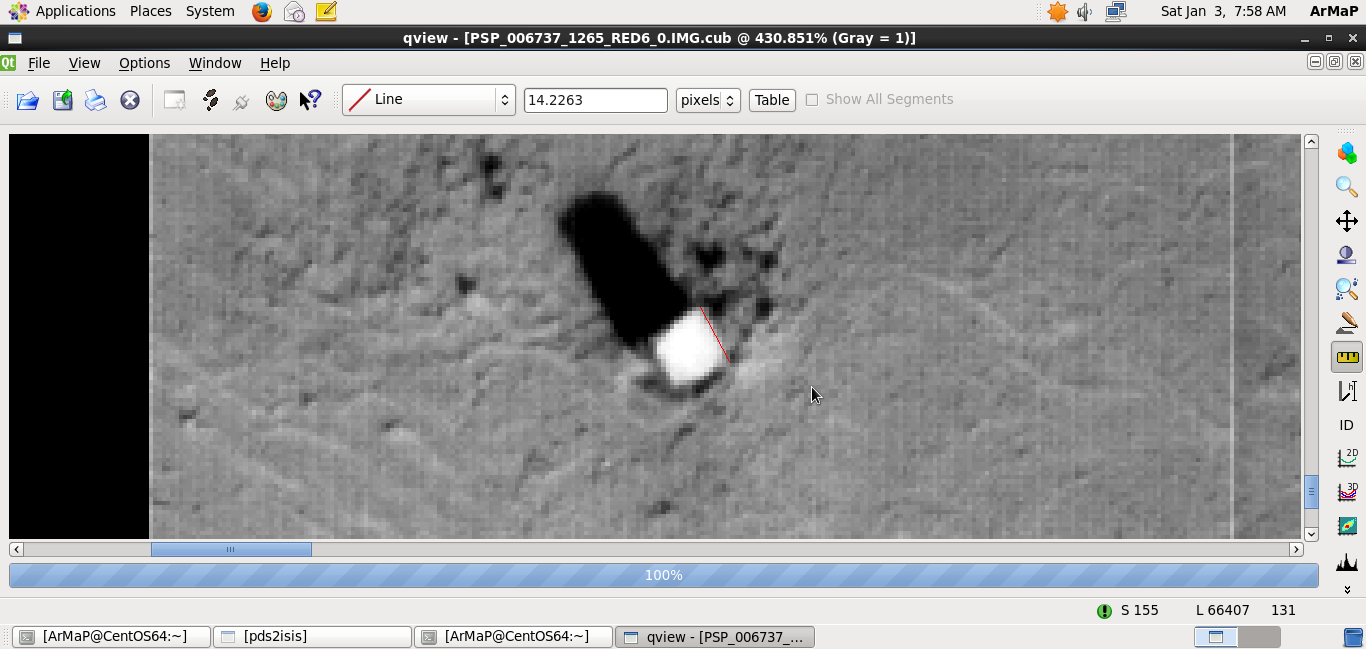
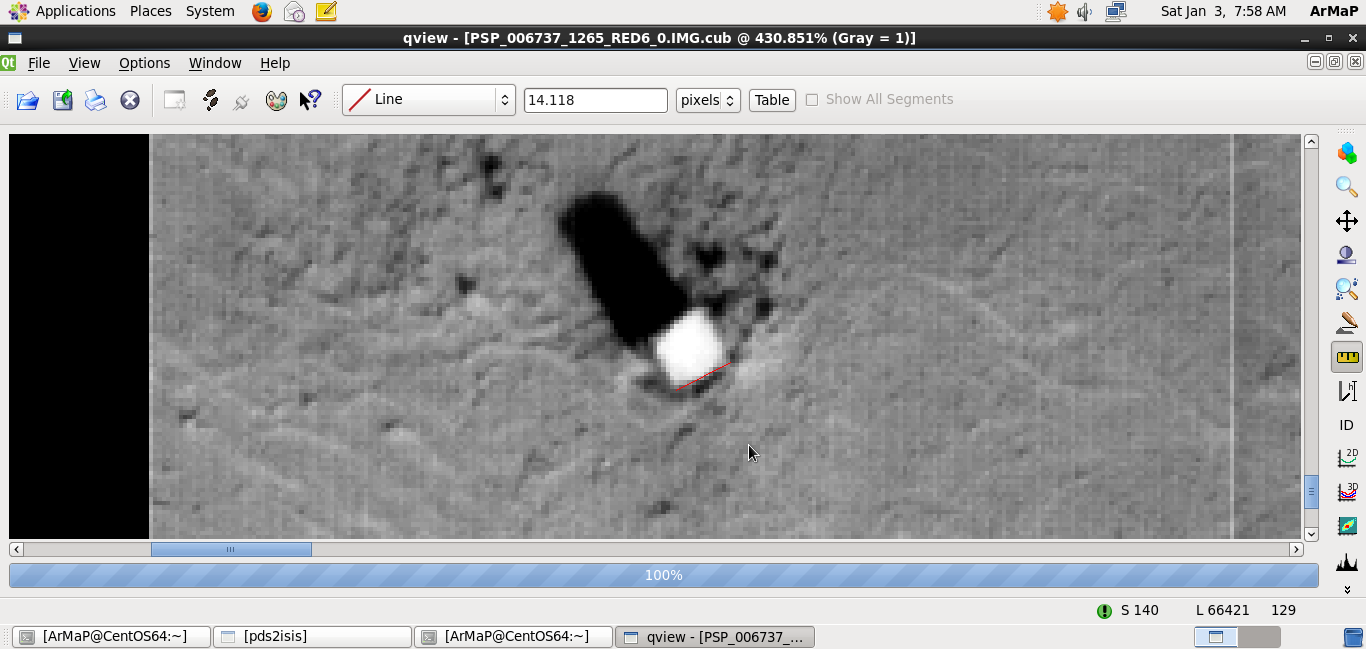
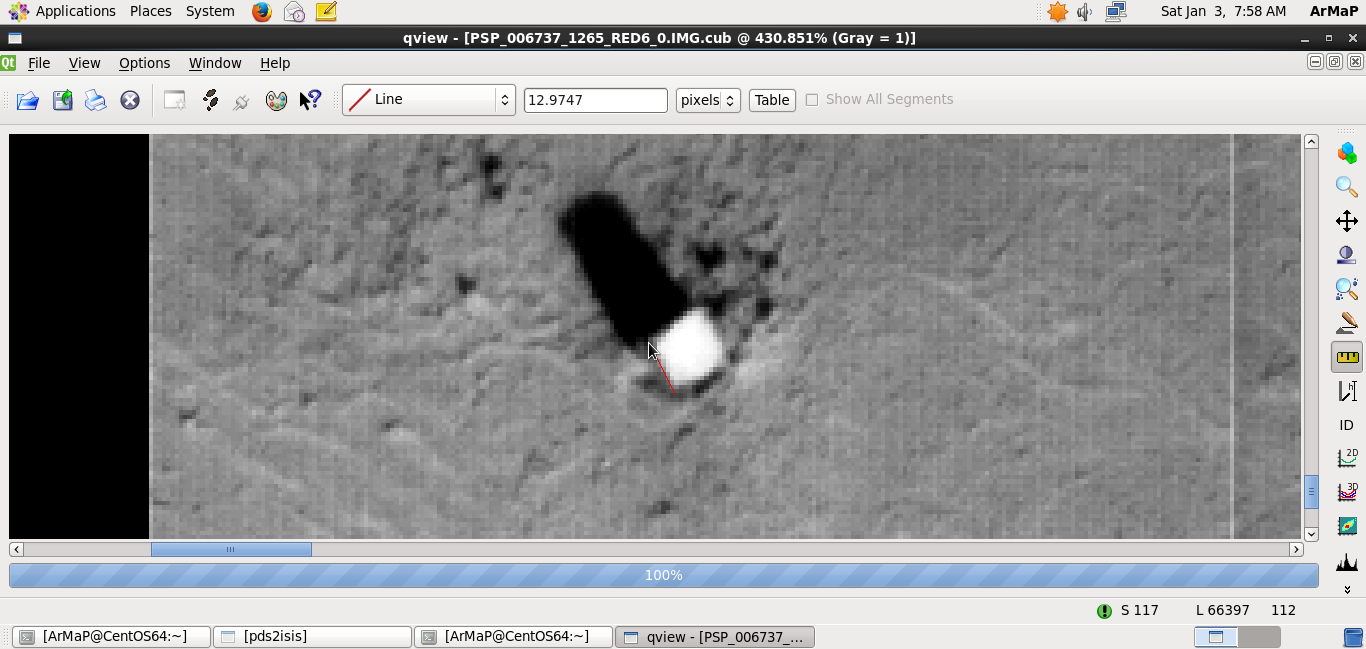

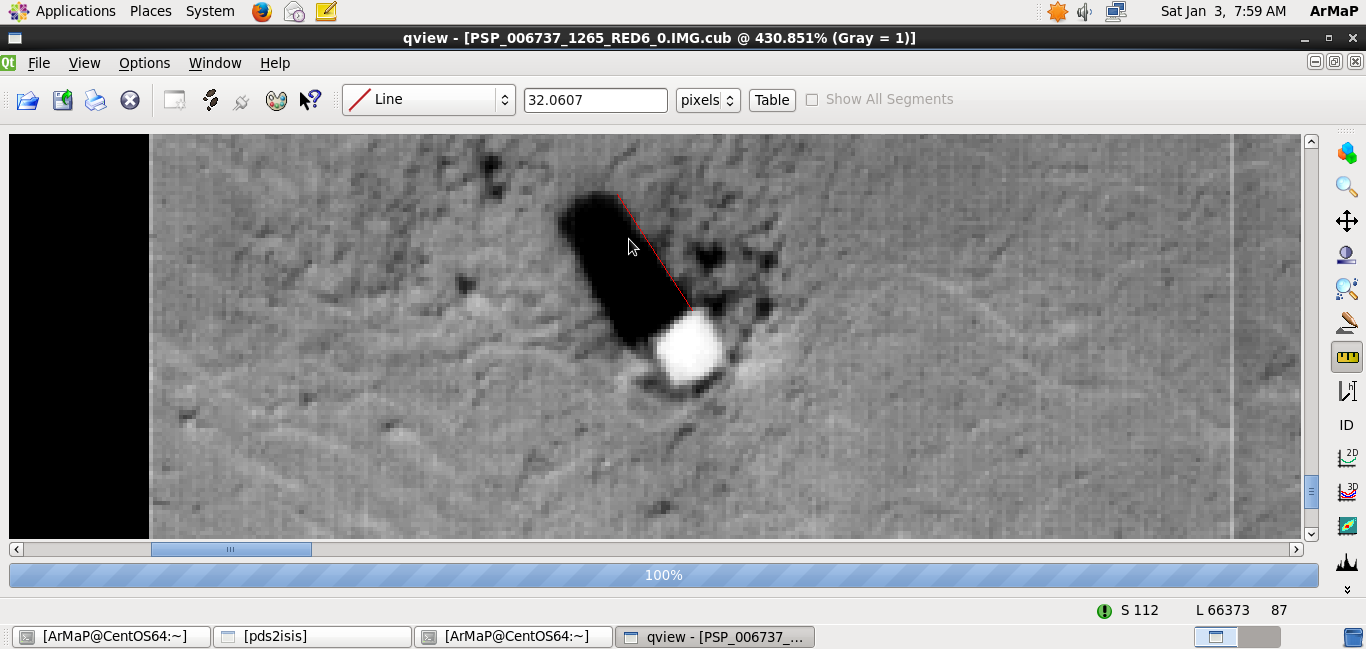

As those are the original images sent by the spacecraft they were not processed, that's why they look worse than the JPEG2000 image and why there wasn't the possibility of getting the measurements in metres, only in pixels.
But, at 25 cm (0.25 metres) per pixel, the values in pixels in the six images above can be converted to 3.55 metres, 3.52 metres, 3.24 metres and 3.52 metres for the rock and 8.01 metres and 8.47 metres for the shadow.
Using the "Solar incidence angle" on the image page (68°, with the Sun about 22° above the horizon) we can get a height of 8.01*tan(22º)=3.23 metres and 8.47*tan(22º)=3.42 metres.
Looking at the photo it looks like the shadow on the left side is longer because the ground is slightly deeper on that side, with (apparently) a difference of some 19 cm.
Unless I got it wrong somewhere.
PS: of those 20 IMG files, the one that has the cubic(ish) rock is PSP_006737_1265_RED6_0.IMG.
edit on 3/1/2015 by ArMaP because: (no reason given)
new topics
-
The functionality of boldening and italics is clunky and no post char limit warning?
ATS Freshman's Forum: 25 minutes ago -
Meadows, Giuliani Among 11 Indicted in Arizona in Latest 2020 Election Subversion Case
Mainstream News: 1 hours ago -
Massachusetts Drag Queen Leads Young Kids in Free Palestine Chant
Social Issues and Civil Unrest: 1 hours ago -
Weinstein's conviction overturned
Mainstream News: 2 hours ago -
Supreme Court Oral Arguments 4.25.2024 - Are PRESIDENTS IMMUNE From Later Being Prosecuted.
Above Politics: 4 hours ago -
Krystalnacht on today's most elite Universities?
Social Issues and Civil Unrest: 4 hours ago -
Chris Christie Wishes Death Upon Trump and Ramaswamy
Politicians & People: 4 hours ago -
University of Texas Instantly Shuts Down Anti Israel Protests
Education and Media: 6 hours ago -
Any one suspicious of fever promotions events, major investor Goldman Sachs card only.
The Gray Area: 8 hours ago
top topics
-
VP's Secret Service agent brawls with other agents at Andrews
Mainstream News: 17 hours ago, 11 flags -
Krystalnacht on today's most elite Universities?
Social Issues and Civil Unrest: 4 hours ago, 7 flags -
Weinstein's conviction overturned
Mainstream News: 2 hours ago, 6 flags -
Supreme Court Oral Arguments 4.25.2024 - Are PRESIDENTS IMMUNE From Later Being Prosecuted.
Above Politics: 4 hours ago, 5 flags -
Electrical tricks for saving money
Education and Media: 16 hours ago, 5 flags -
University of Texas Instantly Shuts Down Anti Israel Protests
Education and Media: 6 hours ago, 3 flags -
Meadows, Giuliani Among 11 Indicted in Arizona in Latest 2020 Election Subversion Case
Mainstream News: 1 hours ago, 3 flags -
Any one suspicious of fever promotions events, major investor Goldman Sachs card only.
The Gray Area: 8 hours ago, 2 flags -
Massachusetts Drag Queen Leads Young Kids in Free Palestine Chant
Social Issues and Civil Unrest: 1 hours ago, 2 flags -
God's Righteousness is Greater than Our Wrath
Religion, Faith, And Theology: 13 hours ago, 1 flags
active topics
-
University of Texas Instantly Shuts Down Anti Israel Protests
Education and Media • 155 • : CriticalStinker -
Meadows, Giuliani Among 11 Indicted in Arizona in Latest 2020 Election Subversion Case
Mainstream News • 3 • : network dude -
Any one suspicious of fever promotions events, major investor Goldman Sachs card only.
The Gray Area • 9 • : xuenchen -
President BIDEN Vows to Make Americans Pay More Federal Taxes in 2025 - Political Suicide.
2024 Elections • 145 • : ImagoDei -
Massachusetts Drag Queen Leads Young Kids in Free Palestine Chant
Social Issues and Civil Unrest • 7 • : nugget1 -
Nearly 70% Of Americans Want Talks To End War In Ukraine
Political Issues • 86 • : Consvoli -
-@TH3WH17ERABB17- -Q- ---TIME TO SHOW THE WORLD--- -Part- --44--
Dissecting Disinformation • 674 • : Thoughtful3 -
Supreme Court Oral Arguments 4.25.2024 - Are PRESIDENTS IMMUNE From Later Being Prosecuted.
Above Politics • 51 • : Threadbarer -
VP's Secret Service agent brawls with other agents at Andrews
Mainstream News • 53 • : confuzedcitizen -
Cats Used as Live Bait to Train Ferocious Pitbulls in Illegal NYC Dogfighting
Social Issues and Civil Unrest • 21 • : confuzedcitizen
